
Search Wild Foods Home Garden & Nature's Restaurant Websites:
Serviceberry Group
Contents of this Page:
- Allegheny Serviceberry
- Downy Serviceberry
- Mountain Juneberry or Oblongfruit Serviceberry
- Canadian Serviceberry
- Inland Juneberry
- Nantucket Serviceberry
- Roundleaf Serviceberry
- Dwarf Serviceberry
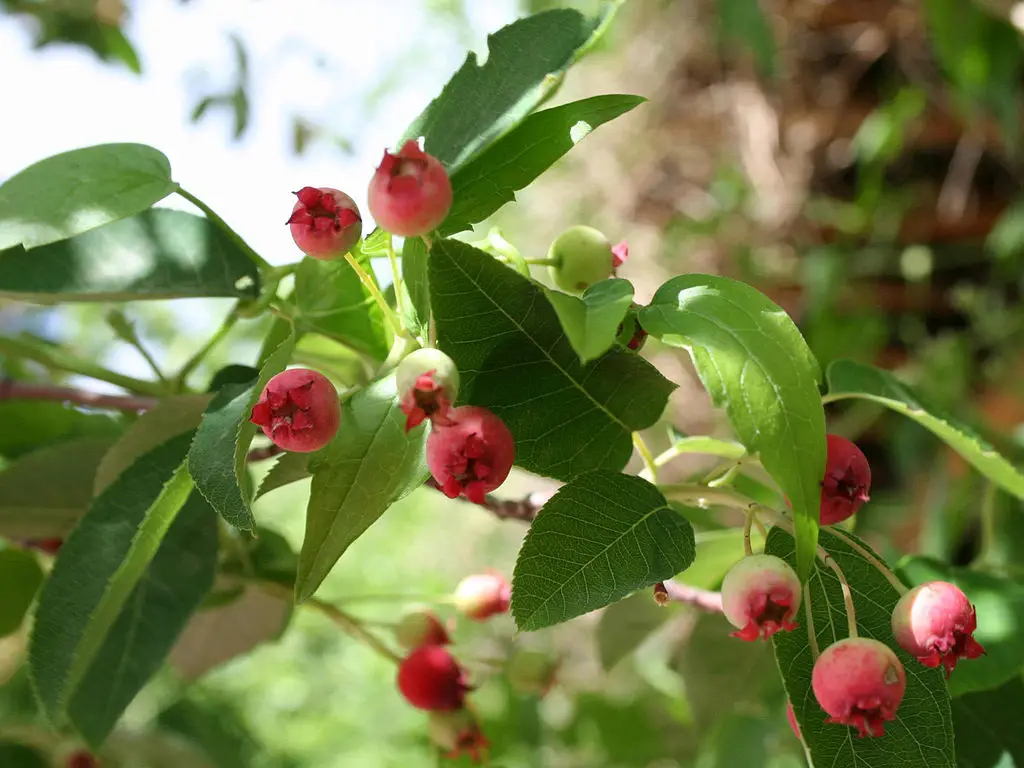
Allegheny Serviceberry or Smooth Serviceberry (Amelanchier laevis). (By: Vanessa Richins CC BY-SA 3.0)
(NOTE: If you are not interested in growing Serviceberries, but just finding the fruit and using it, try going to the Nature's Restaurant Online site Serviceberry page.)
Serviceberries Amelanchier. The Serviceberries have many common names: Chuckley Pear, Juneberry, Serviceberry, Saskatoon, Shadblow, Sugarplum, Wild Pear, Wild-Plum. There are many species within this group. They can be shrub like, to tree sized. All have edible berries which are technically a pome. Apples are a pome, Rose Hips are a pome, and the Serviceberry is part of the Rose Rosaceae family. On most, the berries are sweet and juicy, some (like the Downy Serviceberry) the fruit is dry and tasteless. All are edible, none are poisonous, so if you know it is a Serviceberry, you can try the berry. One of the great bonuses of this member of the Rose family is that it does not have thorns. By the way, it is hard to distinguish one Serviceberry from another, but from an eating perspective it is not that important once you are able to identify it as a Serviceberry. When red, the fruit looks like Crabapples, and usually has the remnants of the flower dried up on the bottom of the fruit like Rose hips.
Often bush sized, some can reach tree size. Even when tree sized, usually they are under 30 feet tall, and less than 30 cm (1 foot) in diameter. Very rarely they can grow larger. If it is tree sized, the trunk will have little taper, and be fairly straight. The bark is smooth and grey. There are vertical lines in the bark on larger trunks, which curve to one side - not straight up and down. The vertical lines are a darker grey. Almost every time I see one, they look more like a large bush with multiple trunks coming from the same place in the ground, or on a single trunk, dividing close the ground and the branches going upwards on an angle except for the center ones. The branches grow upwards, though sometimes will be bent over. The branches are slender. It is a nice looking shrub/tree the way the branches grow. The five long pedalled white flowers appear in clusters on thin stalks at the ends of branches as the leaves are growing.
Often you can find varieties of Serviceberries at nurseries. If you want one, but live where the soil is dry, sandy, and neutral to slightly alkaline, there still is one for you - the Roundleaf Serviceberry (Amelanchier sanguinea). If you live where the soil is dry and sandy or rocky but acidic, there is the Dwarf Serviceberry (Amelanchier spicata).
Seeds: Growing from seed can be a slow process. There are different ways to do it, but the simplest is to just plant the seed where you want them - in the right conditions of course. When you get fruit in the fall, separate the seeds from the fruit and plant about 6 mm (1/4 inch) deep. Cover that with mulch and leave. Only a quarter to half will sprout, but plant enough to take that into consideration. They should start showing up the next spring. They are slow to grow at first, then take off in the second and third years.
Cuttings: Propagation by cuttings can be done, but the results can be disappointing. Not suggested except for a person with a lot of experience doing this.
Transplanting: Best way to get this one for free is to transplant root suckers. These plants spread by the roots, so find where a small one is coming up from the roots of a larger one, cut off some of the root with it, and plant in a pot and put where it gets good light, but not direct sunlight. You must keep the soil damp. You can also plant one of these directly in the ground, but again make sure it does not dry out and does not get full, direct sun until it has fully established and is starting to grow again.
Soil & Site: A great choice for growing at home if you have the right conditions. Other than one member - the Roundleaf Serviceberry - this is not a shrub/tree you would choose to grow on alkaline soils like limestone soils. For most of them you will need neutral to slightly acidic soil, at least partial sun, and a good amount of moisture in the soil, but not standing water. Not a good choice if your soil regularly dries up unless you are prepared to water. If you do have the right conditions, you will be rewarded with a beautiful flowering plant in the spring, great eating berries starting in late May in some areas, and beautiful fall foliage.
Planting: When preparing the spot to plant one, keep in mind this shrub/tree does not like its roots to dry out. For that reason, make sure while meeting the needs of the specific variety you plant, that the soil is very rich in organic matter. A good amount of peat moss, leaf mulch, bark mulch and even vermiculite dug into the soil is a very good idea. Composted manure or compost is perfect for nutrients. After planting, cover the surrounding area with a good layer of mulch - which also keeps the soil moist, but make sure you don't create a mound of mulch right at the base of it. Water well after planting and keep moist without fail for the first season, and after that don't let it get bone dry.
Maintenance: It will sprout suckers around it, but if you plant in a lawn area where you mow around it regularly, that is a non-issue, though it is good to remember the trunk is very sensitive to damage, so don't hit it or use a weed whacker right against the tender bark or you will girdle the tree and kill it. It doesn't even require hard pruning.
Harvesting: The fruit is small reddish or purplish, has several hard seeds, and on most the flesh is sweet and juicy. They ripen between late June to early August.
Using: Good fresh or cooked into pies, jams, etc. By the way, you can eat the seeds, and when cooked, the seeds soften and don't take away from the texture.
Recipe search on the web here (Google search) and here (Bing search).
The Biota of North America Program (BONAP) distribution map of all the Serviceberries in North America here. BONAP map color key here.
Below are descriptions of the ones you are most likely to find growing in Eastern North America.
Allegheny Serviceberry
Allegheny Serviceberry or Smooth Serviceberry (Amelanchier laevis). Known also as the Smooth Shadbush. Often planted as an ornamental for the beautiful showy flowers and red fall foliage. The fruit is sweet and juicy.
Description:
- USDA Plant Hardiness Zone: 4-8 (More information on hardiness zones).
- Soil pH: no specific data, but acidic to neutral is where they are found
- Plant Size: Small tree reaching 9 meters (30 feet) tall, most often has multiple trunks coming from the ground.
- Leaf Shape: Elliptic to Ovate
- Leaf Phyllotaxis (Arrangement) on branch: Alternate
- Leaf Size: Generally 4-9 cm (1 2/3 to 3 1/2 inches) long, 2.5-4 cm (1 to 1 2/3 inches) wide
- Leaf Margin: Serrated (saw toothed edge)
- Leaf Notes: Turns a beautiful red with some yellow in the fall
- Flowers: Five narrow petalled white flower, flowers in April to June
- Fruit: Ripe in June and July. Red when unripe, a purple-blue when ripe. 1-2 cm (2/5 to 4/5 inch) diameter
- Bark: Light silvery grey with darker grey vertical lines
- Habitat: Open areas within all forest types, edges of woods, fields, waste areas, power line openings
Web Resources:
- Pictures on the web here (Google images) and here (Bing images).
- Interactive USDA distribution map and plant profile here.
- The Biota of North America Program (BONAP) distribution map here. BONAP map color key here.
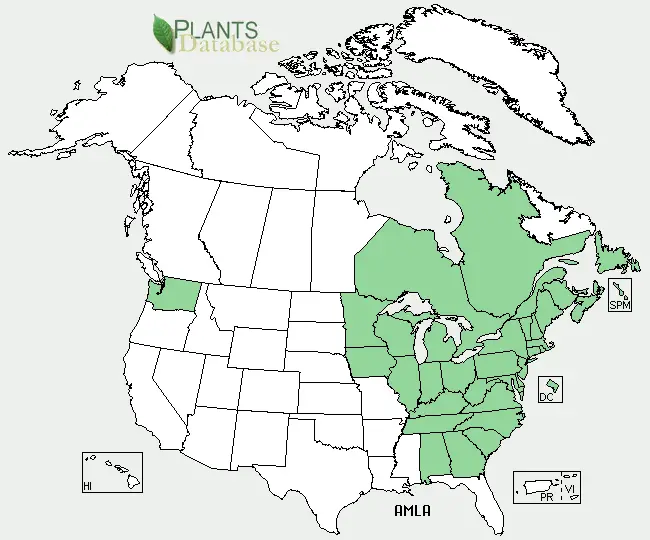
Allegheny Serviceberry or Smooth Serviceberry (Amelanchier laevis) range. Distribution map courtesy of U. S. Department of Agriculture (USDA Natural Resources Service) and used in accordance with their policies.
Allegheny Serviceberry or Smooth Serviceberry (Amelanchier laevis). Typical shape. (By: Sherief Saleh CC BY-SA 3.0)

Allegheny Serviceberry or Smooth Serviceberry (Amelanchier laevis) leaves and fruit. (By: Vanessa Richins CC BY-SA 3.0)
Allegheny Serviceberry or Smooth Serviceberry (Amelanchier laevis) leaves. (By: Sherief Saleh CC BY-SA 3.0)
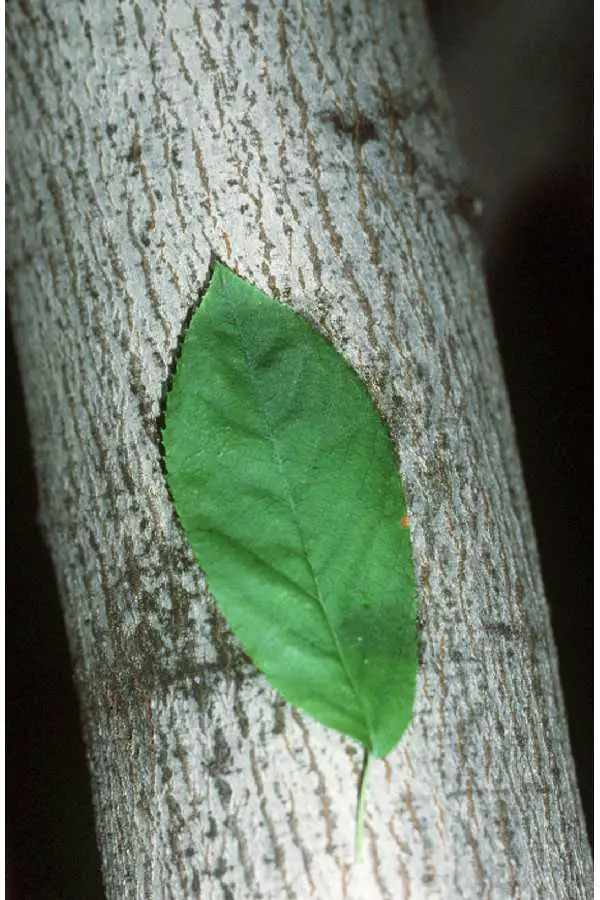
Allegheny Serviceberry or Smooth Serviceberry (Amelanchier laevis) leaf and bark. (By: Robert H. Mohlenbrock, hosted by the USDA-NRCS PLANTS Database / USDA SCS. 1991. Southern wetland flora: Field office guide to plant species. South National Technical Center, Fort Worth.)
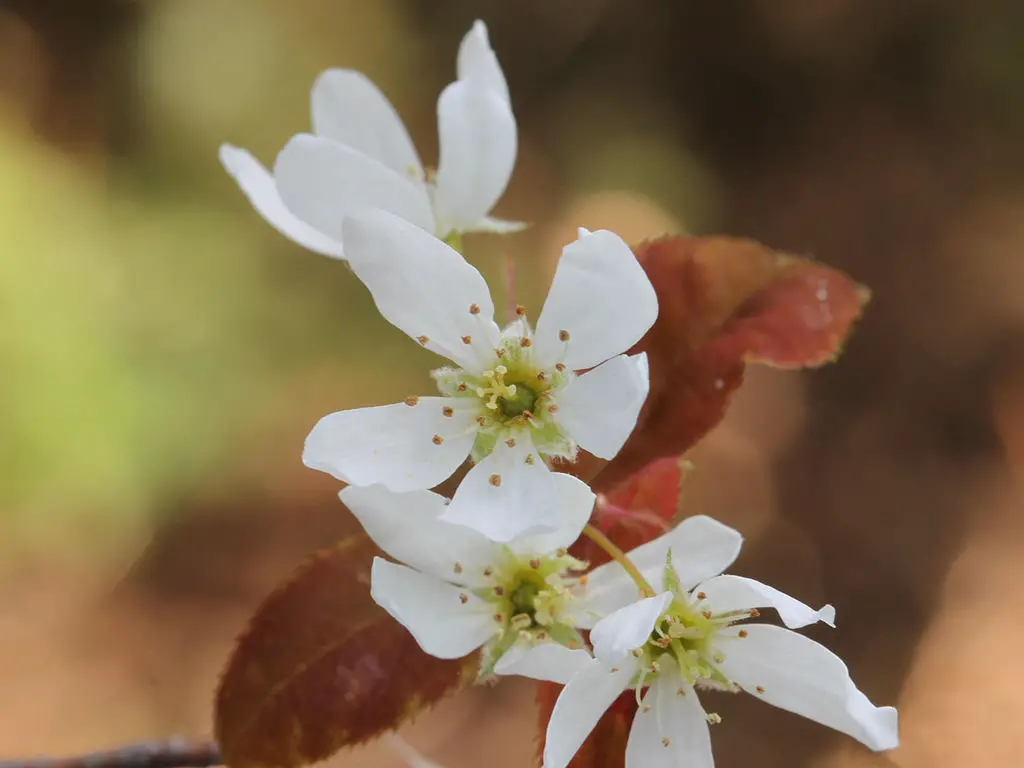
Allegheny Serviceberry or Smooth Serviceberry (Amelanchier laevis) flowers. (By: Rob Routledge, Sault College CC BY-SA 3.0)
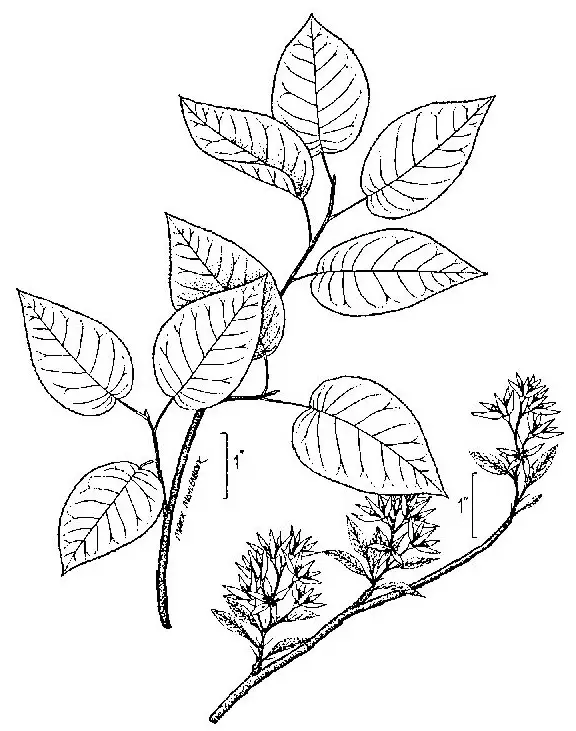
Allegheny Serviceberry or Smooth Serviceberry (Amelanchier laevis) drawing. (By: USDA-NRCS PLANTS Database / USDA NRCS. Wetland flora: Field office illustrated guide to plant species. USDA Natural Resources Conservation Service.)
Downy Serviceberry
Downy Serviceberry (Amelanchier arborea). Known also as the Common Serviceberry. The fruit is good to eat but is not as juicy as some (drier). Good for baked goods and jams. Others are better fresh.
Description:
- USDA Plant Hardiness Zone: 4-9 (More information on hardiness zones).
- Soil pH: 5.5-7.0
- Plant Size: Generally up to 12 meters (40 feet) high, but occasionally can get taller. Trunks are normally up to 15 cm (6 inches) in diameter, but have be known to be more than double that on rare occasions.
- Leaf Shape: Elliptic to Ovate
- Leaf Phyllotaxis (Arrangement) on branch: Alternate
- Leaf Size: Generally 4-9 cm (1 2/3 to 3 1/2 inches) long, 2.5-4 cm (1 to 1 2/3 inches) wide, but can get bigger occasionally
- Leaf Margin: finely Serrated (saw toothed edge)
- Leaf Notes: When the leaves are young, they are downy on the bottom side - hence the name "Downy Serviceberry"
- Flowers: Five petalled white flowers in clusters in spring. Each flower is up to 2.5 cm (1 inch) diameter. 4-10 flowers per raceme (cluster)
- Fruit: Ripe in summer, reddish-purple color when ripe, often tree is cleaned out of ripe (even unripe) fruit before you can find any.
- Bark: Smooth, grey.
- Habitat: Likes full sun in moist but not wet soil. Will grown in part shade, but there is less fruit.
Web Resources:
- Pictures on the web here (Google images) and here (Bing images).
- Interactive USDA distribution map and plant profile here.
- The Biota of North America Program (BONAP) distribution map here. BONAP map color key here.
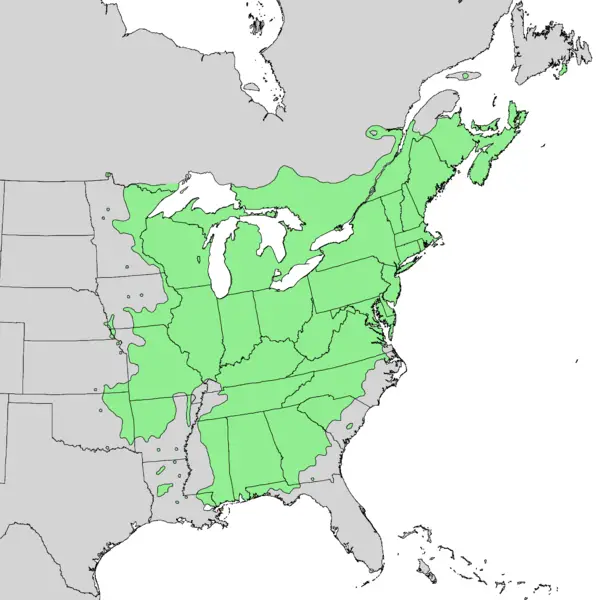
Downy Serviceberry (Amelanchier arborea) range. Distribution map courtesy of the USGS Geosciences and Environmental Change Science Center, originally from "Atlas of United States Trees" by Elbert L. Little, Jr. .
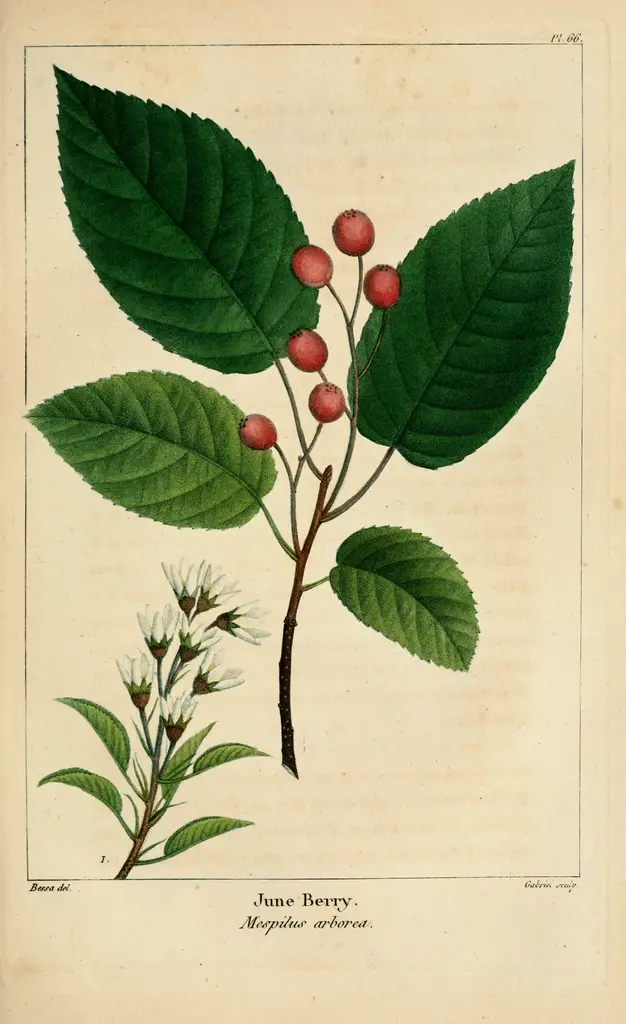
Downy Serviceberry (Amelanchier arborea) illustration. (By: François André Michaux (book author), Augustus Lucas Hillhouse (translator), Pancrace Bessa (illustrator), Gabriel (engraver))
Downy Serviceberry (Amelanchier arborea) leaves. (By: Dcrjsr CC BY-SA 3.0)
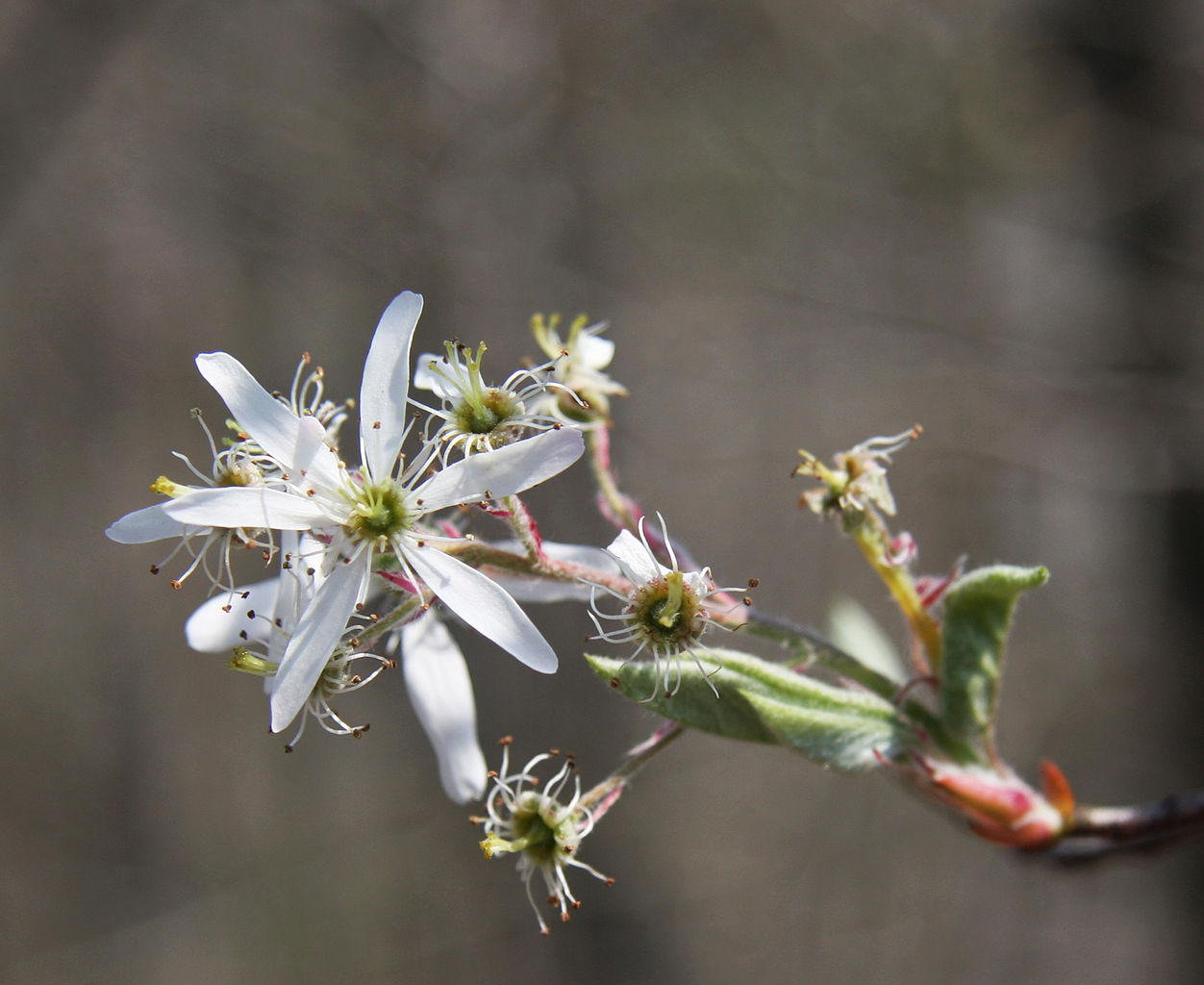
Downy Serviceberry (Amelanchier arborea) flowers. (By: Dcrjsr CC BY-SA 3.0)
Mountain Juneberry or Oblongfruit Serviceberry
Mountain Juneberry or Oblongfruit Serviceberry (Amelanchier bartramiana). Other common names for it include: Bartram Juneberry, Bartram's Serviceberry, Mountain Shadbush, Mountain Serviceberry, Northern Juneberry.
This is one of the smaller Serviceberries and is associated with colder, wetter areas. Often found in fields in areas that have conifer forests. Very often near water where there is more light. The leaves tend to be bunched up near the ends of the branches. White flowers in the spring, and fruit in summer. Can be upright, or bent over especially in rocky areas.
Description:
- USDA Plant Hardiness Zone: 4-8 (More information on hardiness zones).
- Soil pH: no data, but acidic to neutral is where they grow
- Plant Size: Up to 2 meters (6 feet) tall, can be a low, sprawling bush
- Duration: Perennial Shrub
- Leaf Shape: Egg shaped - widest part nearer tip than base
- Leaf Phyllotaxis (Arrangement) on branch: Alternate
- Leaf Size: Up to 6 cm (2 1/3 inches) long
- Leaf Margin: finely Serrated (saw toothed edge)
- Leaf Notes: Upper and lower sides are hairless, leaves tend to be grouped near ends of branches leaving lower sections bare
- Flowers: Clusters of 1-4 flowers with 5 white petals, each flower about 2 cm (4/5 inch) diameter, flowers in May to early June
- Fruit: Ripe in July to August, purplish-black, berry-like, 1 cm (2/5 inch) diameter, edible and good raw and cooked, fruit is oblong shaped - not spherical
- Bark: Upper, smaller twigs and branches are reddish, older and thicker branches are grey, larger lower branches are grey and can have tan with red center dots on bark
- Habitat: Generally associated with boreal forests, but can be found in others. Generally moist to damp soils, but occasionally in drier soils. Often by rivers, shores of smaller lakes and creeks in woods openings.
Web Resources:
- Pictures on the web here (Google images) and here (Bing images).
- Interactive USDA distribution map and plant profile here.
- The Biota of North America Program (BONAP) distribution map here. BONAP map color key here.
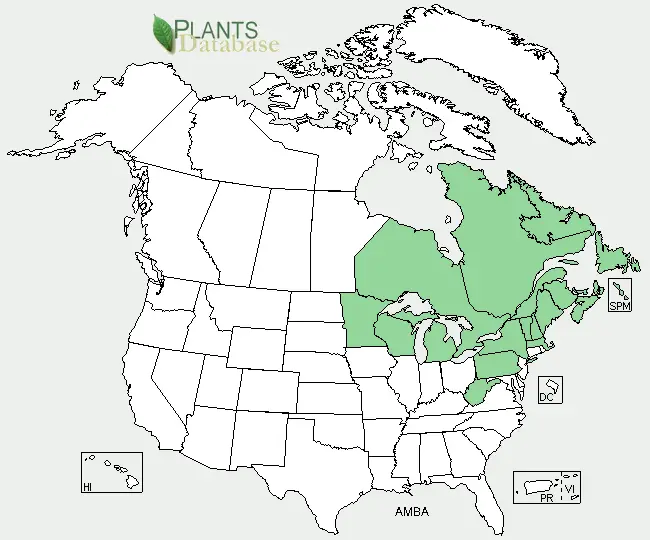
Mountain Juneberry or Oblongfruit Serviceberry (Amelanchier bartramiana) range. Distribution map courtesy of U. S. Department of Agriculture (USDA Natural Resources Service) and used in accordance with their policies.
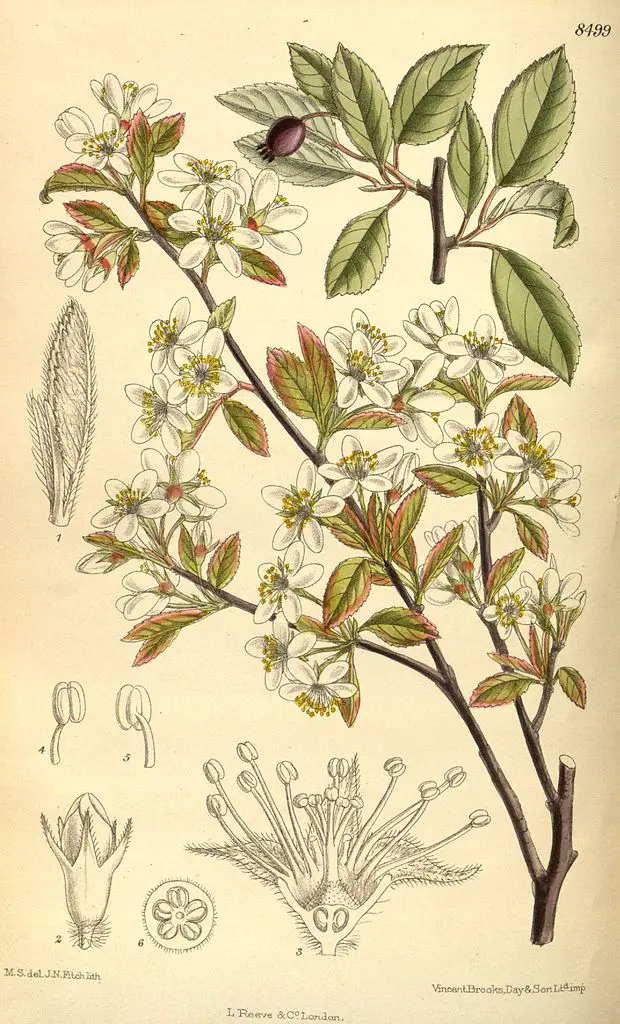
Mountain Juneberry or Oblongfruit Serviceberry (Amelanchier bartramiana) illustration. (By: M.S. del, J.N.Fitch, lith. Curtis's Botanical Magazine, London., vol. 139)
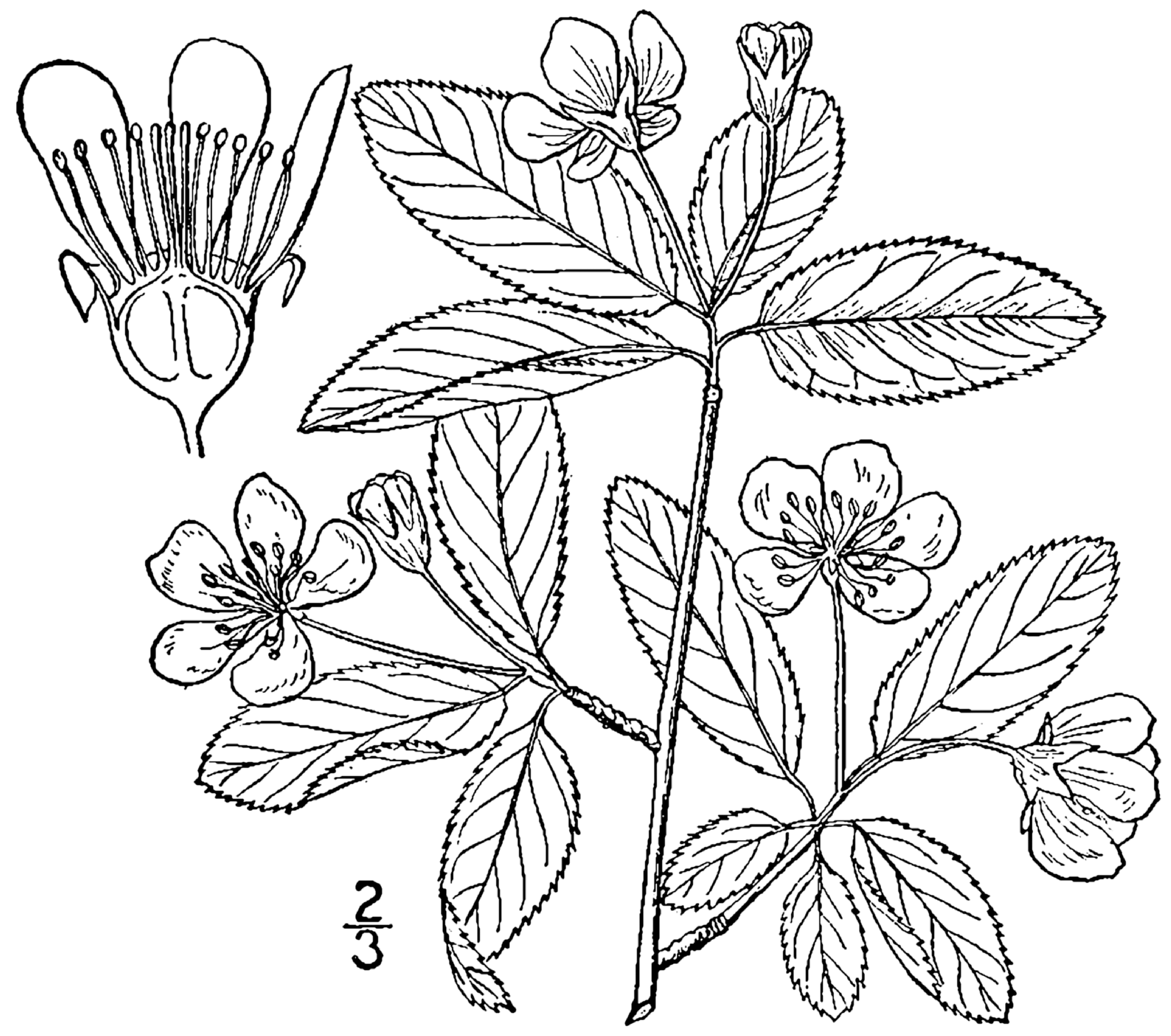
Mountain Juneberry or Oblongfruit Serviceberry (Amelanchier bartramiana) drawing. (USDA-NRCS PLANTS Database / Britton, N.L., and A. Brown. 1913. An illustrated flora of the northern United States, Canada and the British Possessions. 3 vols. Charles Scribner's Sons, New York. Vol. 2: 293.)
Canadian Serviceberry
Canadian Serviceberry (Amelanchier canadensis). Known also as the Chuckleberry, Currant-tree, Juneberry, Shadblow Serviceberry, Shadblow, Shadbush, Shadbush Serviceberry, Sugarplum, Thicket Serviceberry. This Serviceberry is most likely to be found where the ground is damp to wet all the time. This is a very beautiful small tree/shrub when you see it in the early spring covered in white flowers or in the fall with its orange-red to crimson red fall foliage. The fruit is good to eat fresh or cooked.
Description:
- USDA Plant Hardiness Zone: 4-7 (More information on hardiness zones).
- Soil pH: 5.0-7.5
- Plant Size: Generally up to 6 meters (20 feet), but occasionally taller. Usually shrub like with multiple trunks/branches coming from the same spot in the ground, though sometimes more like a tree with a central trunk and horizontal branches.
- Duration: Perennial Shrub to small tree.
- Leaf Shape: Ovate
- Leaf Phyllotaxis (Arrangement) on branch: Alternate
- Leaf Size: Up to 5 cm (2 inches) long or slightly more. Up to 3 cm (1 1/5 inches) wide
- Leaf Margin: Serrated (saw toothed edge)
- Leaf Notes: Downy on the underside. Bright orange-red to crimson red in fall
- Flowers: 4-10 white petalled flowers on a raceme that comes from the ends of branches
- Fruit: When ripe a purple tinted red, sometimes a dark cranberry red, ripe in June/July, averages about 8-9 mm (1/3 inch) diameter
- Bark: Smooth, grey, very often with large whitish blotches, sometimes vertical lines that are a paler grey to whitish
- Habitat: Damp to wet soils in the very Eastern most provinces and states. Can tolerate alkalinity better than most Serviceberries
Web Resources:
- Pictures on the web here (Google images) and here (Bing images).
- Interactive USDA distribution map and plant profile here.
- The Biota of North America Program (BONAP) distribution map here. BONAP map color key here.
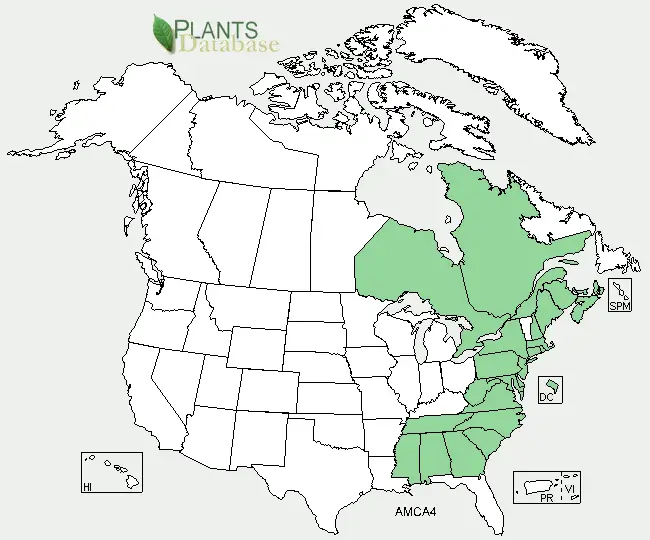
Canadian Serviceberry (Amelanchier canadensis) range. Distribution map courtesy of U. S. Department of Agriculture (USDA Natural Resources Service) and used in accordance with their policies.
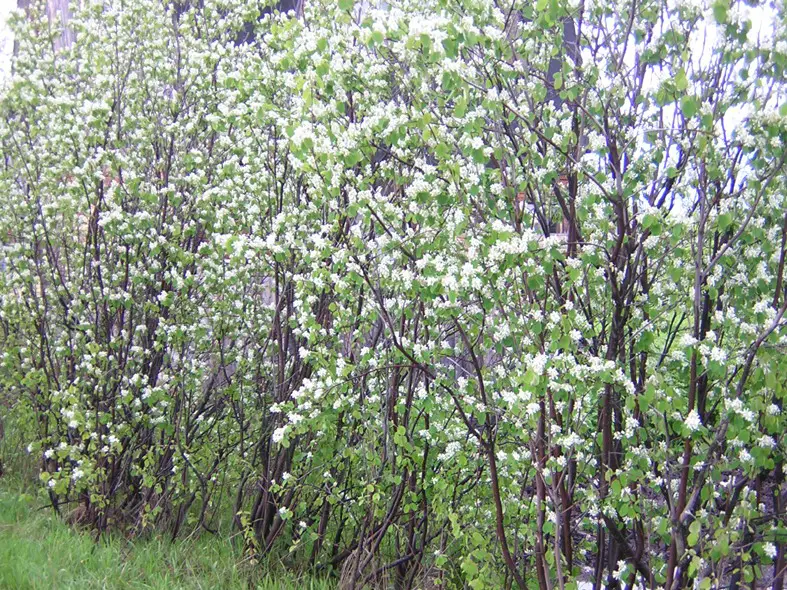
Canadian Serviceberry (Amelanchier canadensis) in bloom. (By: Borealis55)
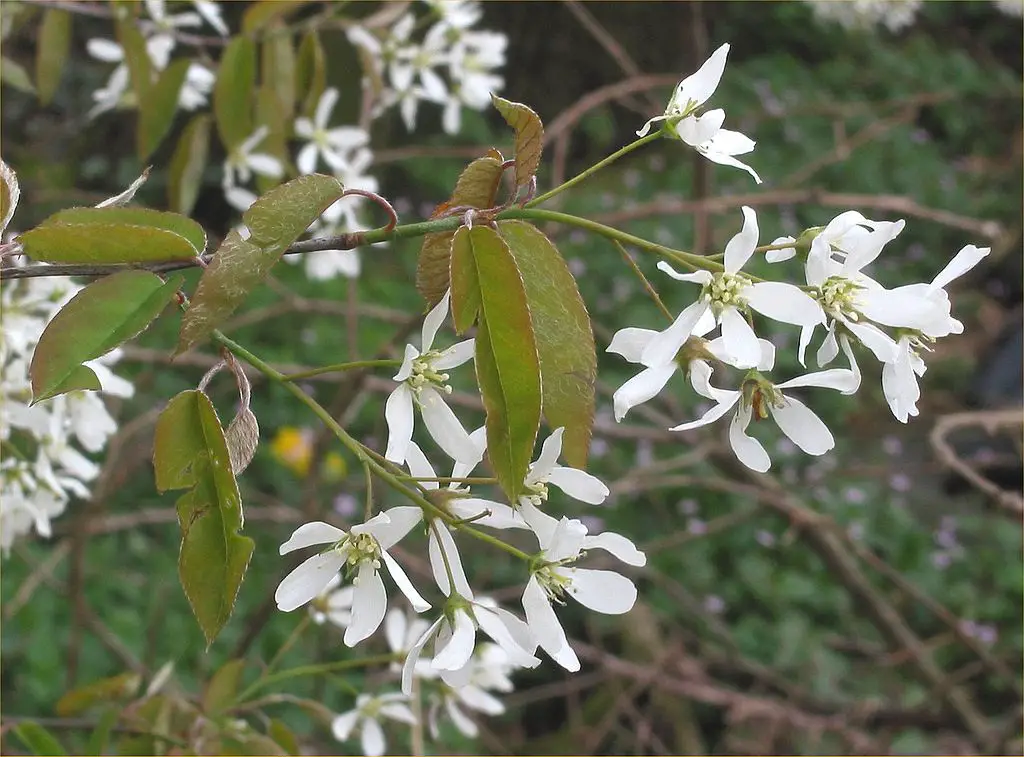
Canadian Serviceberry (Amelanchier canadensis) flowers and leaves. (By: Rasbak GNU Free Documentation License, Version 1.2)
.jpg)
Canadian Serviceberry (Amelanchier canadensis) twigs and leaves. Note how fuzzy or downy the back of the leaves and twigs are. (By: Robert H. Mohlenbrock. USDA NRCS. 1995. Northeast wetland flora: Field office guide to plant species. Northeast National Technical Center, Chester. )
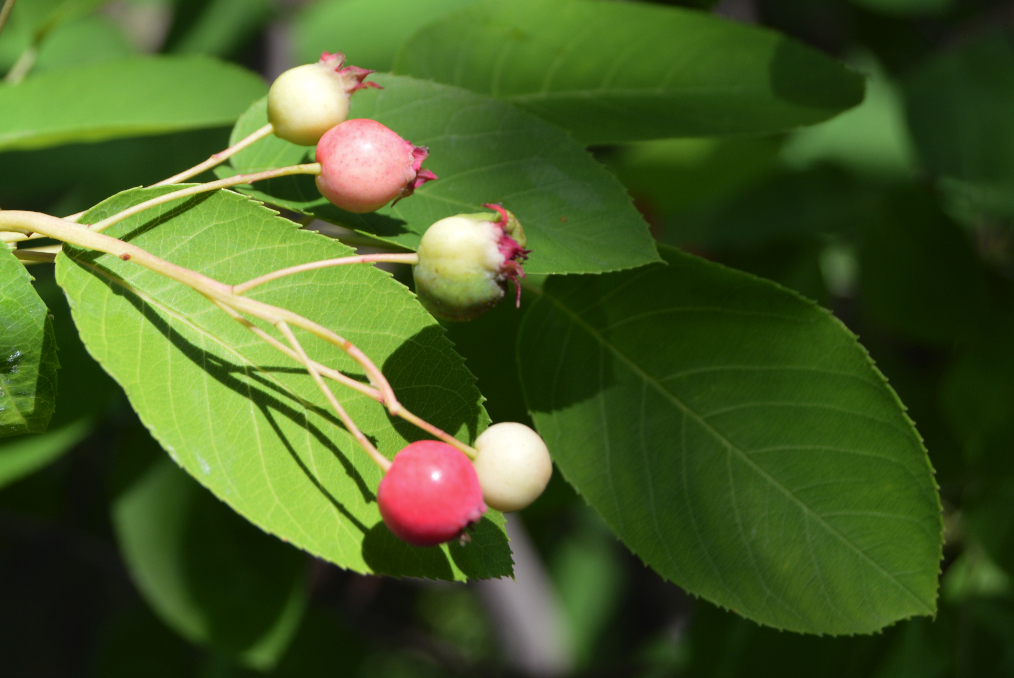
Canadian Serviceberry (Amelanchier canadensis) fruit in various stages of ripeness. (By: Sesamehoneytart Attribution-Share Alike 4.0 International license)
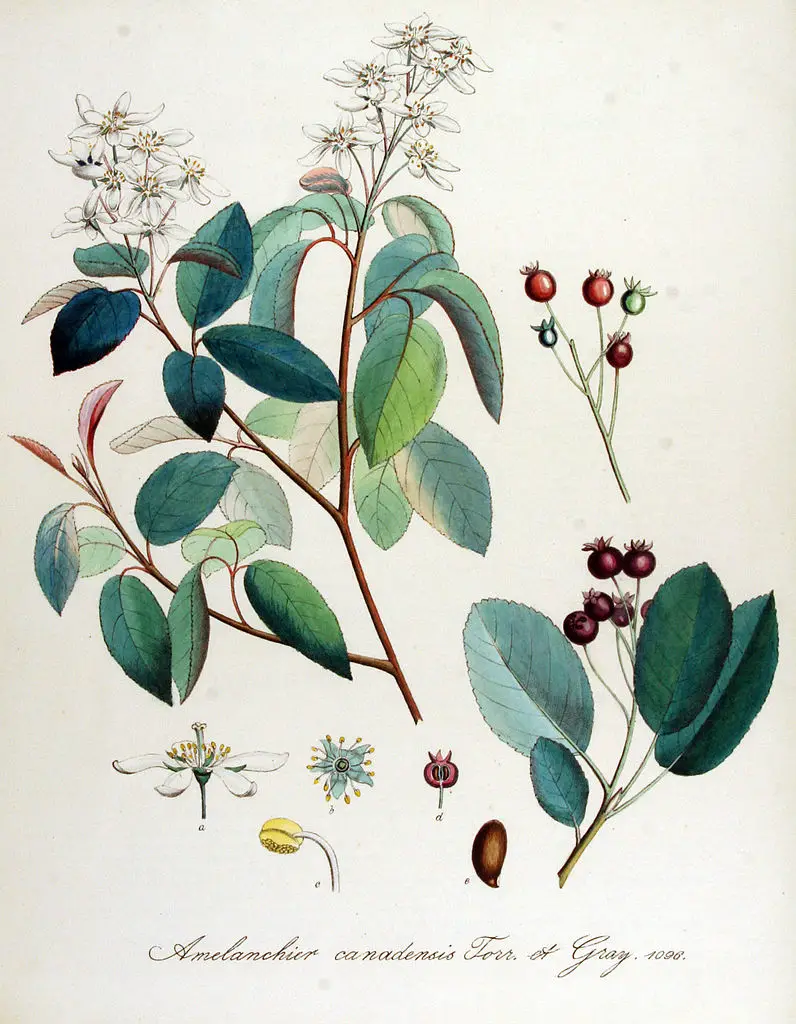
Canadian Serviceberry (Amelanchier canadensis) illustration. (By: Flora Batava of Afbeelding en Beschrijving van Nederlandsche Gewassen, (1872))
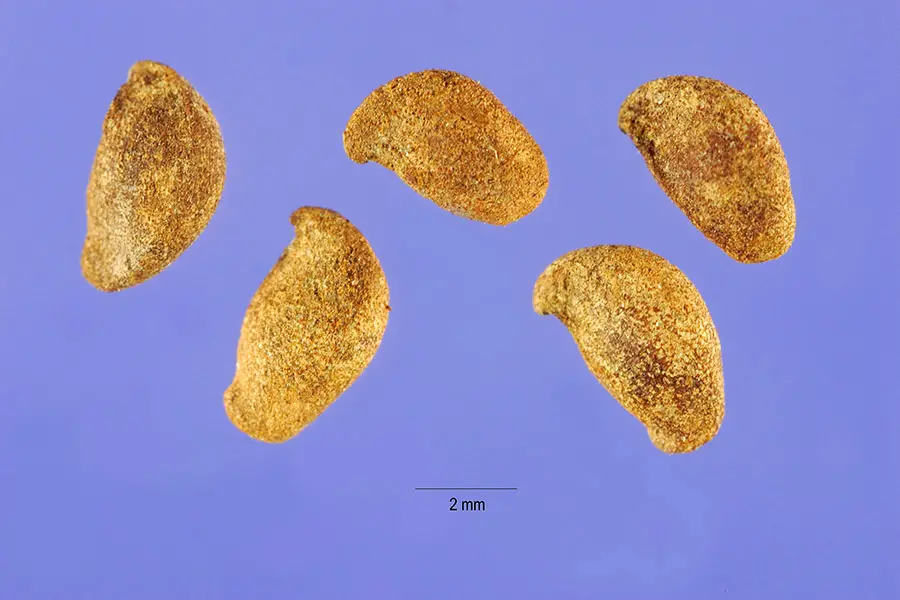
Canadian Serviceberry (Amelanchier canadensis) seeds. (Steve Hurst, hosted by the USDA-NRCS PLANTS Database)
Inland Juneberry
Inland Juneberry (Amelanchier interior). According to the USDA, another name for it is the Pacific Serviceberry, though I find that odd, as its range does not touch the Pacific Coast. Only found west of Lake Superior and Lake Michigan according to some, more widespread according to others (see distribution maps below). Fruit is very good.
Description:
- USDA Plant Hardiness Zone: 5-9 (More information on hardiness zones).
- Soil pH: 5.0-7.5
- Plant Size: Up to 9 meters (30 feet) high
- Duration: Perennial Shrub or small tree
- Leaf Shape: Ovate
- Leaf Phyllotaxis (Arrangement) on branch: Alternate
- Leaf Size: Up to 7 cm (2 3/4 inches) long
- Leaf Margin: Serrated (saw toothed edge), though this is mainly on the end of the leaf nearer the tip in many cases - that is the edges can be smooth or almost so near the base of the leaf
- Leaf Notes: Leaves are reddish colored when very young - one of the better distinguishing features. 8-10 pairs of veins per leaf
- Flowers: In April/May clusters of 5 petalled white flowers
- Fruit: Red to purple, 6-8 mm (1/4 to 1/3 inch) diameter
- Bark: Smooth and grey
- Habitat: Moist soils of varying alkalinity/acidity. Sun to part shade. Due to needing moist soil, is often found near water.
Web Resources:
- Pictures on the web here (Google images) and here (Bing images).
- Interactive USDA distribution map and plant profile here.
- The Biota of North America Program (BONAP) distribution map here. BONAP map color key here.
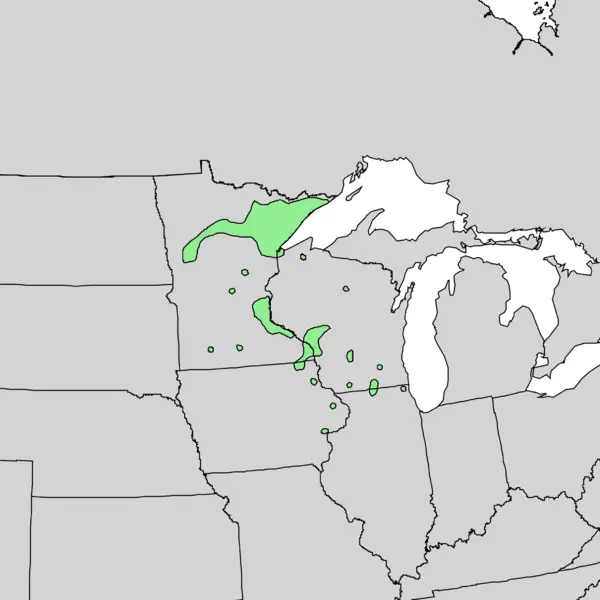
Inland Juneberry (Amelanchier interior) range. Distribution map courtesy of the USGS Geosciences and Environmental Change Science Center, originally from "Atlas of United States Trees" by Elbert L. Little, Jr. .
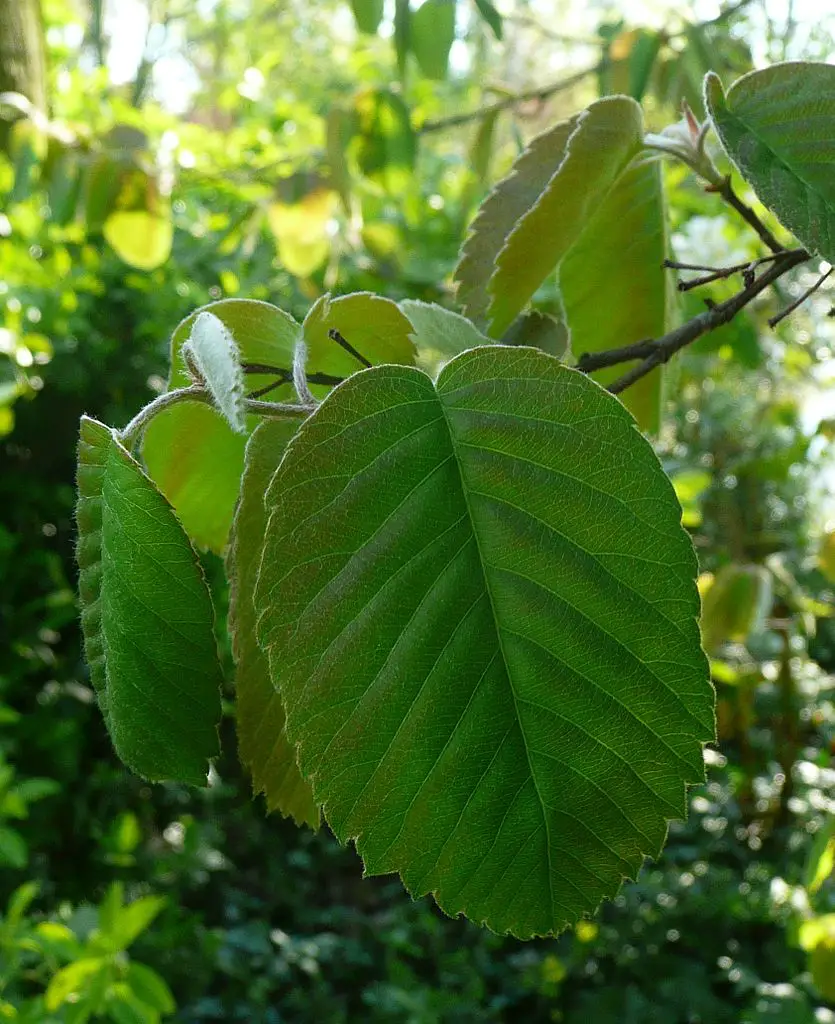
Inland Juneberry (Amelanchier interior) leaves. (By: Adam Hauner Attribution-Share Alike 4.0 International license)
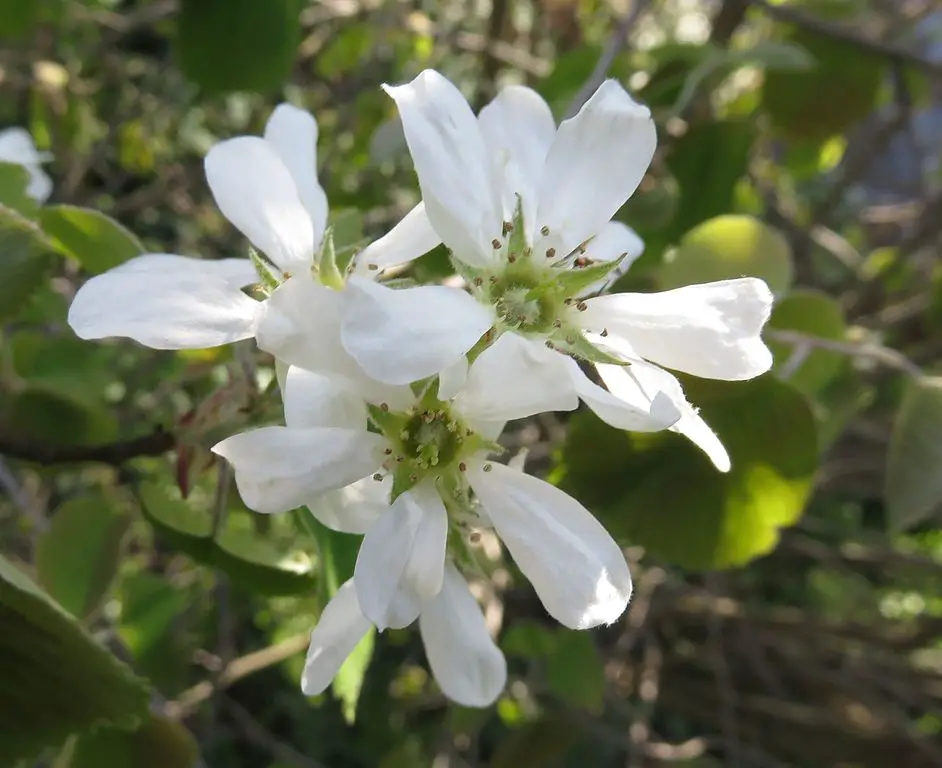
Inland Juneberry (Amelanchier interior) blossoms. (By: Adam Hauner Attribution-Share Alike 4.0 International license)
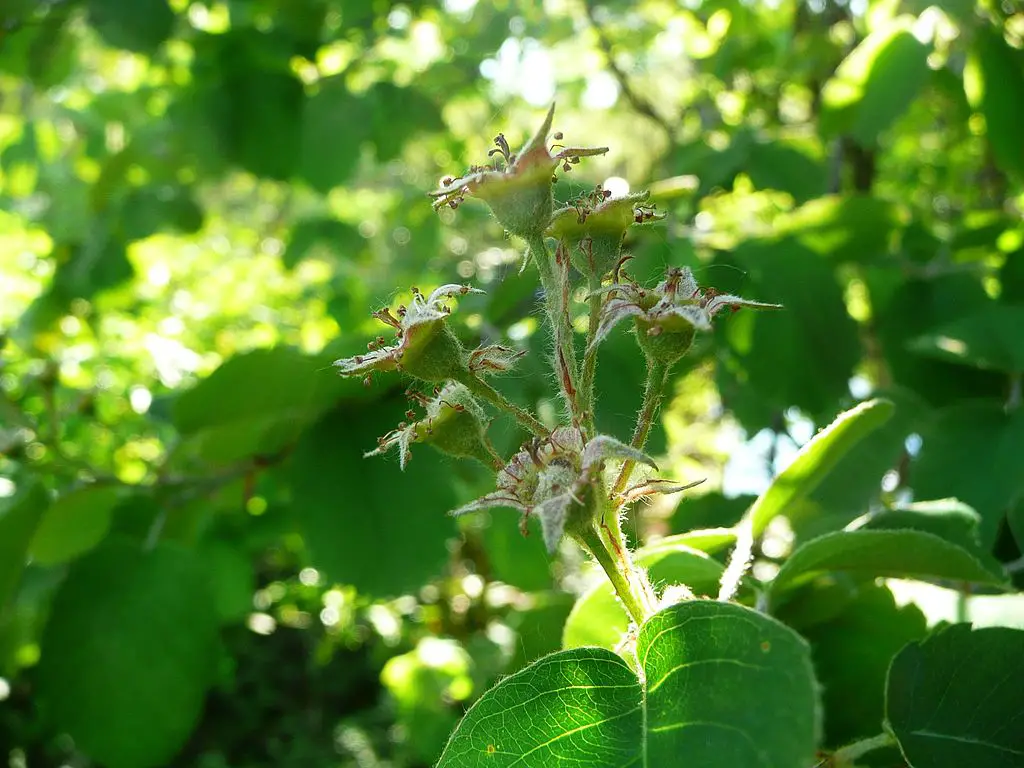
Inland Juneberry (Amelanchier interior) just finished flowering. (By: Adam Hauner Attribution-Share Alike 4.0 International license)
Nantucket Serviceberry
Nantucket Serviceberry (Amelanchier nantucketensis). Found only in on the east coast from upper USA to possibly scattered occurrences on the east coast of Canada. Up to 2 meters (6 feet) tall. Fruit is good fresh or cooked and is a purple-red.
Web Resources:
- Pictures on the web here (Google images) and here (Bing images).
- Interactive USDA distribution map and plant profile here.
- The Biota of North America Program (BONAP) distribution map here. BONAP map color key here.
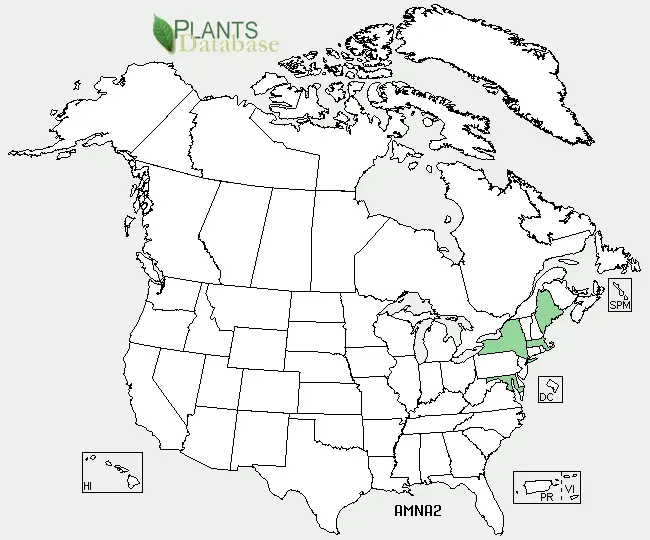
Nantucket Serviceberry (Amelanchier nantucketensis) range. Distribution map courtesy of U. S. Department of Agriculture (USDA Natural Resources Service) and used in accordance with their policies.
Roundleaf Serviceberry
Roundleaf Serviceberry (Amelanchier sanguinea). Known also as the Red-twigged Shadbush and the Sand Serviceberry. All three of the common names are unusually descriptive. The leaves are almost round, the twigs are a reddish-orange, and this one tends to be found where the soil is sandy and neutral to alkaline. This particular Serviceberry can withstand drier conditions that most.
Description:
- USDA Plant Hardiness Zone: 4-8 (More information on hardiness zones).
- Soil pH: 5.0-7.8
- Plant Size: Up to 3 meters (10 feet) tall
- Duration: Perennial Shrub
- Leaf Shape: Ovate to nearly round, hence the name "Roundleaf" Serviceberry
- Leaf Phyllotaxis (Arrangement) on branch: Alternate
- Leaf Size: 2.5–7 cm (1 to 2 3/4 inches) long, 2–5.5 cm (4/5 to 2 1/5 inches) wide
- Leaf Margin: Serrated (saw toothed edge)
- Leaf Notes: The serrated margins are courser than most Serviceberries and tend to have the largest serrations nearer the tip of the leaf and smaller serrations near the base of the leaf
- Flowers: Small clusters of white, 5 petalled flowers. Flowers in May-June.
- Fruit: Purple to dark blue when ripe, red when unripe. Ripe in July-August. 5-8 mm (1/4 to 1/3 inch) diameter, sweet tasting.
- Bark: Smaller upper twigs have a reddish-orange color, mature branches are grey with vertical light tan-orange lines
- Habitat: Drier, sandy soils in open areas of full sun or part shade in neutral to even slightly alkaline soil. Edges of woods, openings in woods, sandy fields, in rocky areas, areas where the soil is sandy and thin, can be found in other sites, but the ones listed are the most common habitat.
Web Resources:
- Pictures on the web here (Google images) and here (Bing images).
- Interactive USDA distribution map and plant profile here.
- The Biota of North America Program (BONAP) distribution map here. BONAP map color key here.
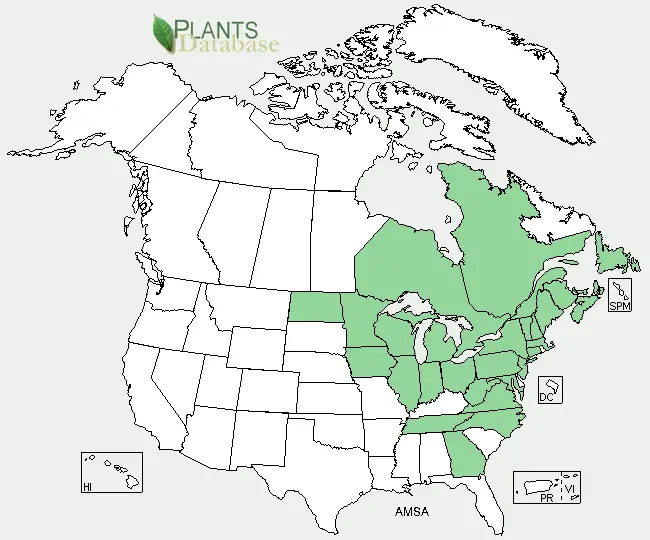
Roundleaf Serviceberry (Amelanchier sanguinea) range. Distribution map courtesy of U. S. Department of Agriculture (USDA Natural Resources Service) and used in accordance with their policies.
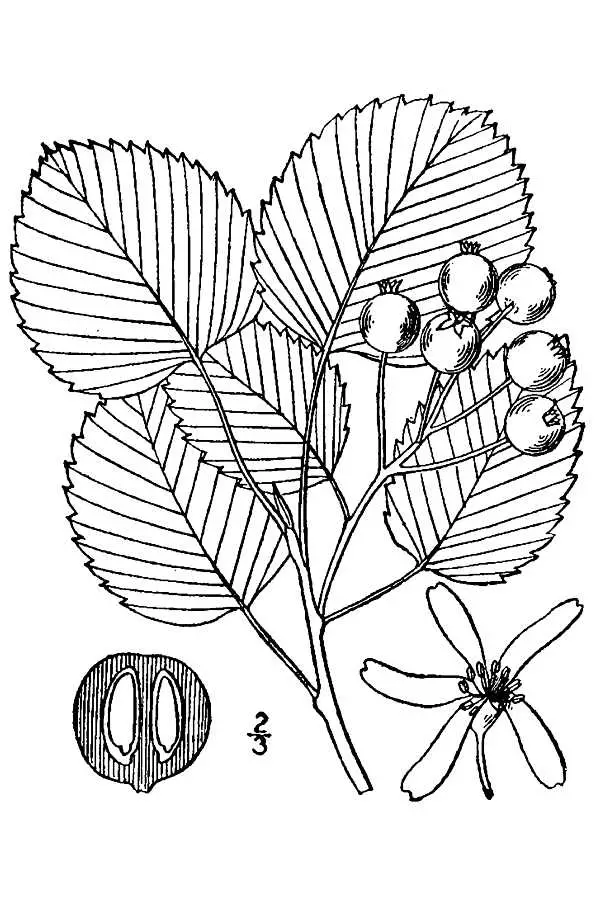
Roundleaf Serviceberry (Amelanchier sanguinea) drawing. (USDA-NRCS PLANTS Database / Britton, N.L., and A. Brown. 1913. An illustrated flora of the northern United States, Canada and the British Possessions. 3 vols. Charles Scribner's Sons, New York. Vol. 2: 293.)
Dwarf Serviceberry
Dwarf Serviceberry (Amelanchier spicata) or (Amelanchier stolonifera). Known also as the Low Juneberry, Low Serviceberry, Pigeon Berry, Quebec Berry, Running Serviceberry, Thicket Shadbush. This one has dense flower clusters with white five petalled flowers and grows in dry, sandy or rocky areas where the soil is acidic. This one forms thickets due to the roots which send up shoots around it, hence one of the names, "Running" Serviceberry.
- Pictures on the web here (Google images) and here (Bing images).
- Interactive USDA distribution map and plant profile here.
- The Biota of North America Program (BONAP) distribution map here. BONAP map color key here.
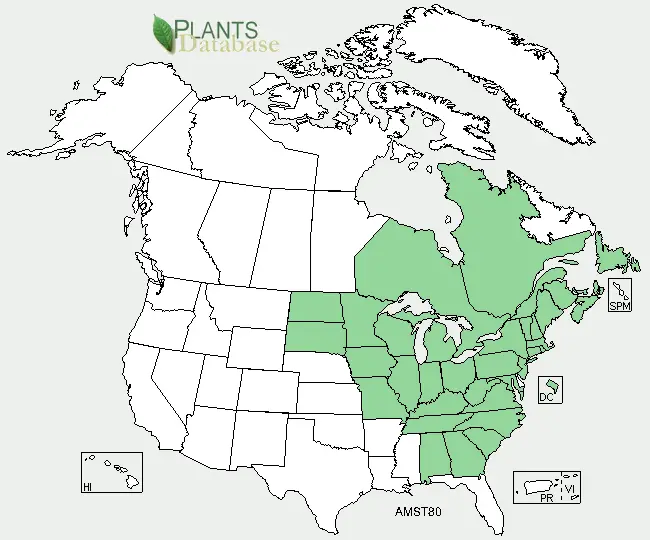
Dwarf Serviceberry (Amelanchier spicata) or (Amelanchier stolonifera) range. Distribution map courtesy of U. S. Department of Agriculture (USDA Natural Resources Service) and used in accordance with their policies.
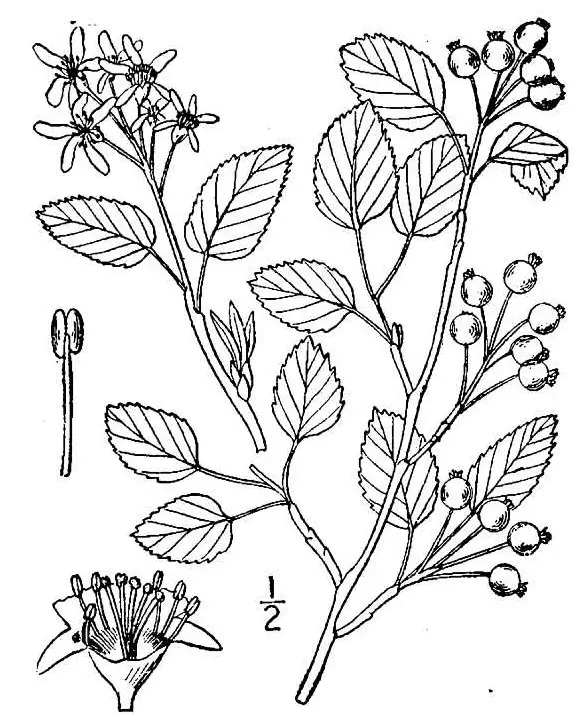
Dwarf Serviceberry (Amelanchier spicata) or (Amelanchier stolonifera) drawing. (USDA-NRCS PLANTS Database / Britton, N.L., and A. Brown. 1913. An illustrated flora of the northern United States, Canada and the British Possessions. 3 vols. Charles Scribner's Sons, New York. Vol. 2: 292.)
Dwarf Serviceberry (Amelanchier spicata) or (Amelanchier stolonifera) leaves and fruit. (By: Tauno Erik GNU Free Documentation License, Version 1.2)
Search Wild Foods Home Garden & Nature's Restaurant Websites:
Share:
Why does this site have ads?
Originally the content in this site was a book that was sold through Amazon worldwide. However, I wanted the information to available to everyone free of charge, so I made this website. The ads on the site help cover the cost of maintaining the site and keeping it available.
Google + profile
